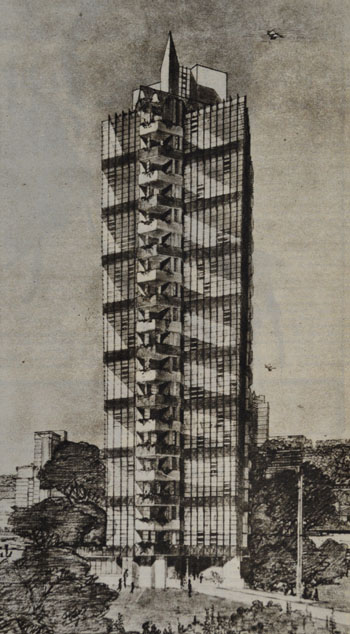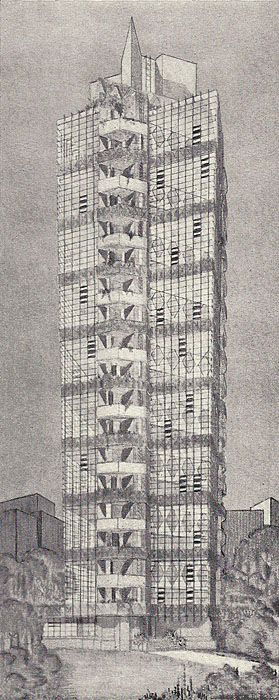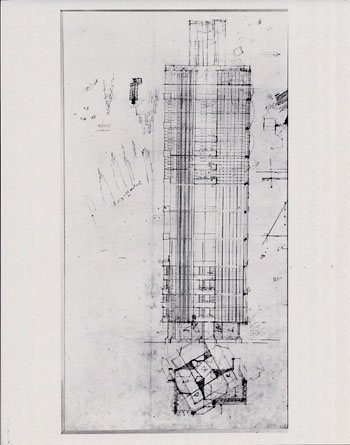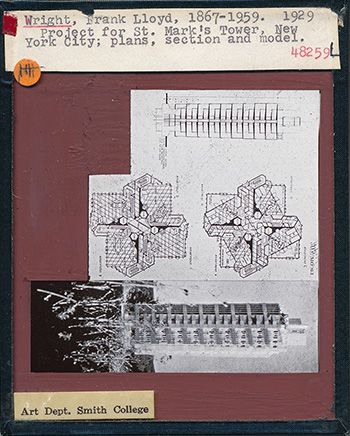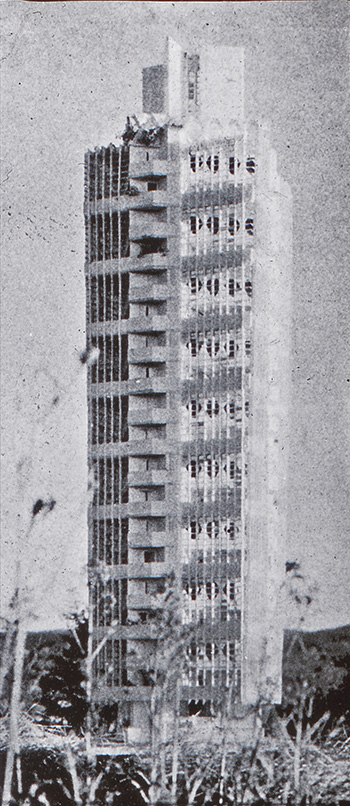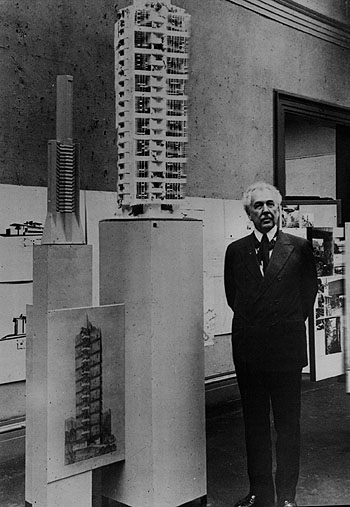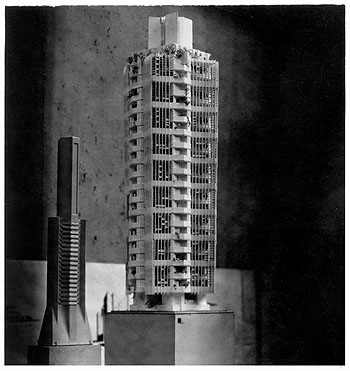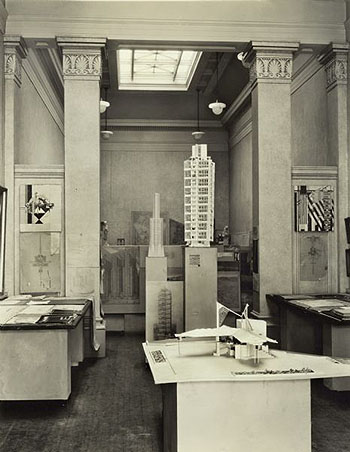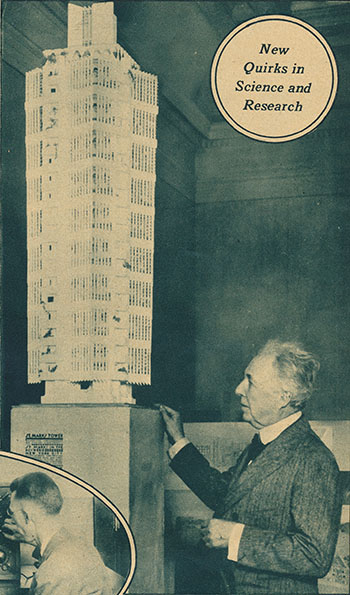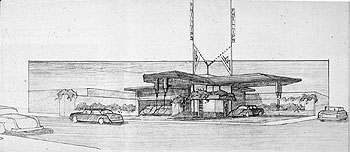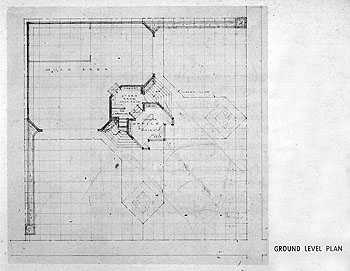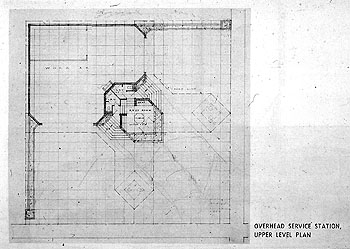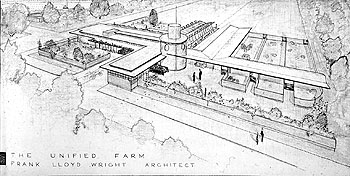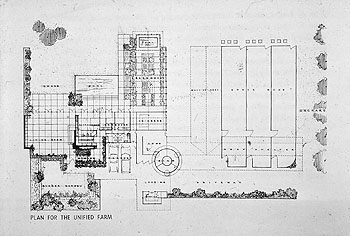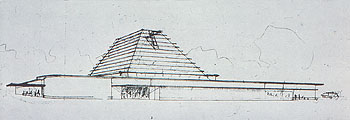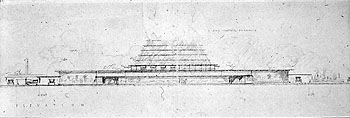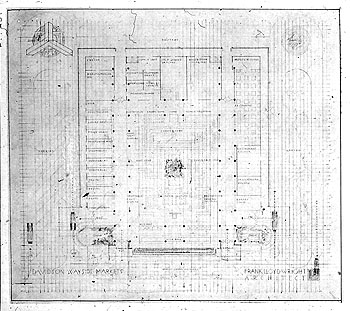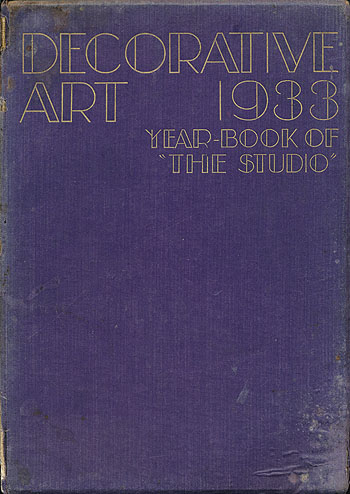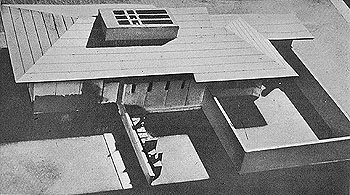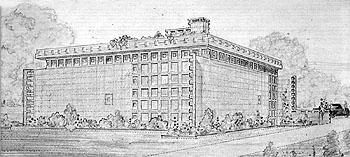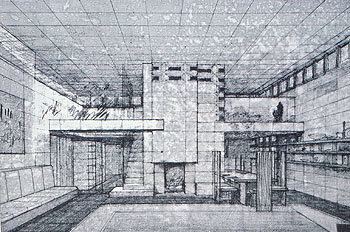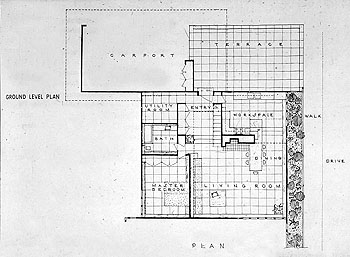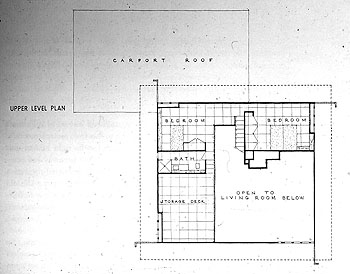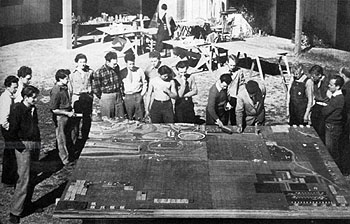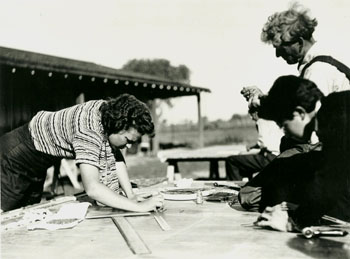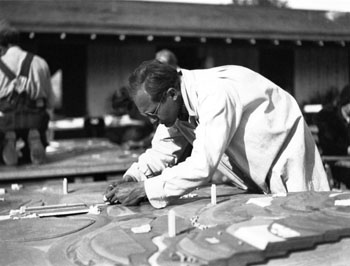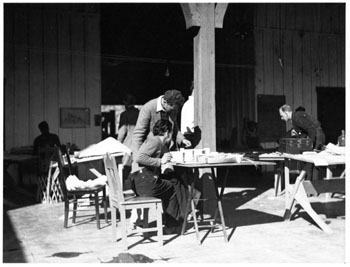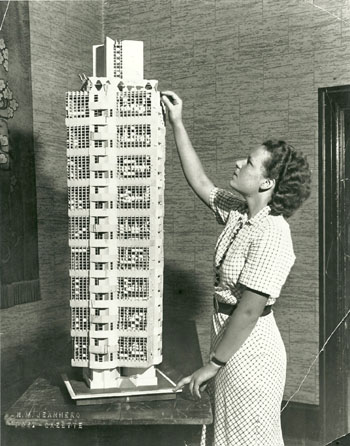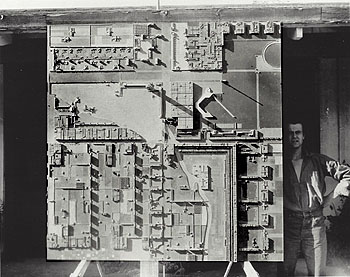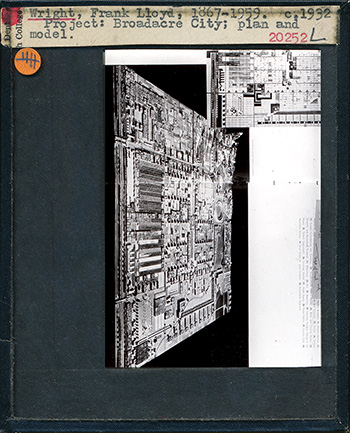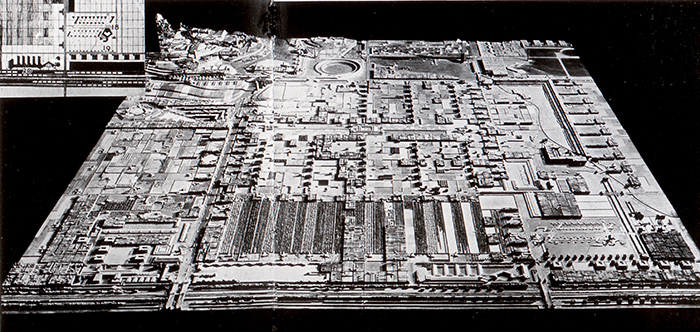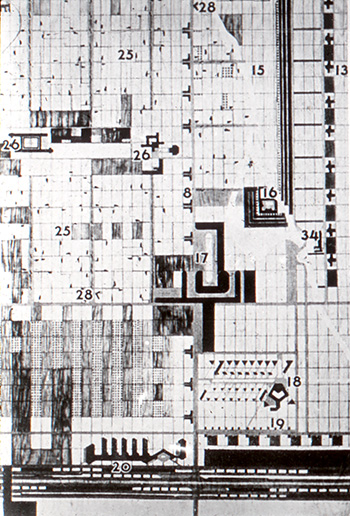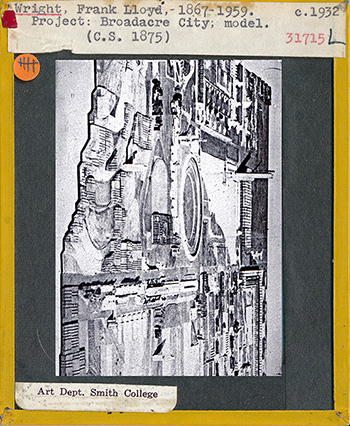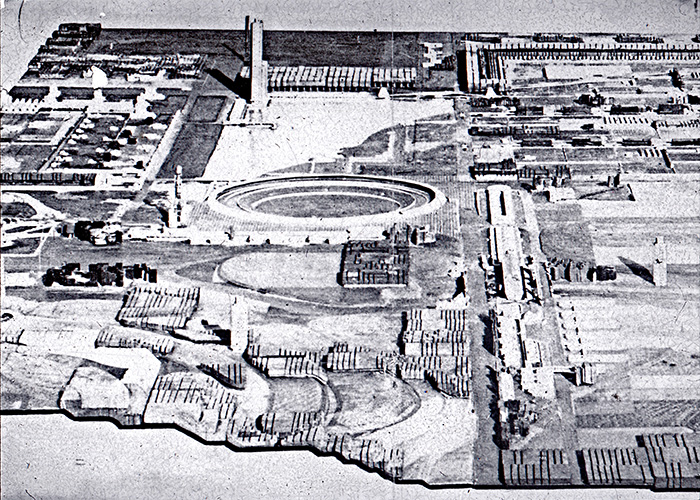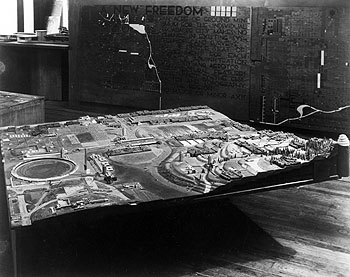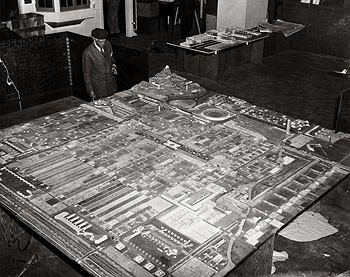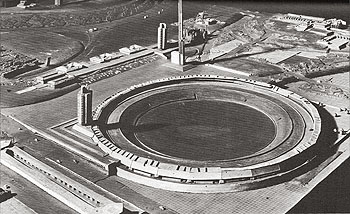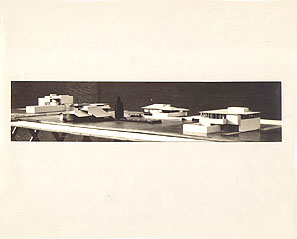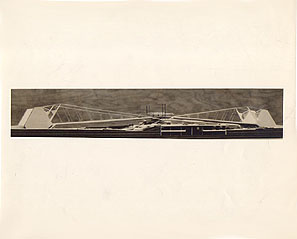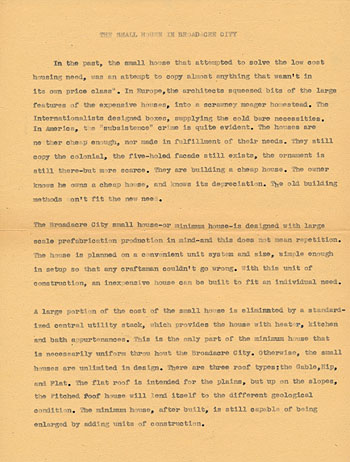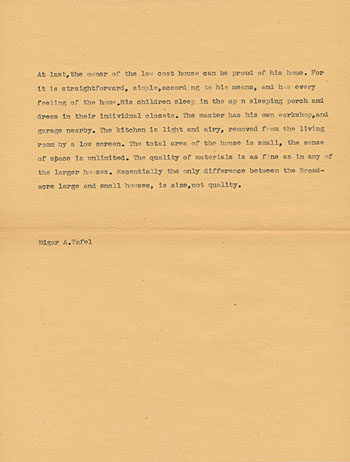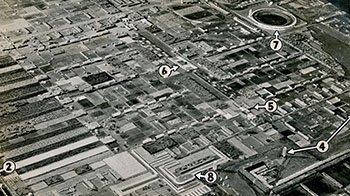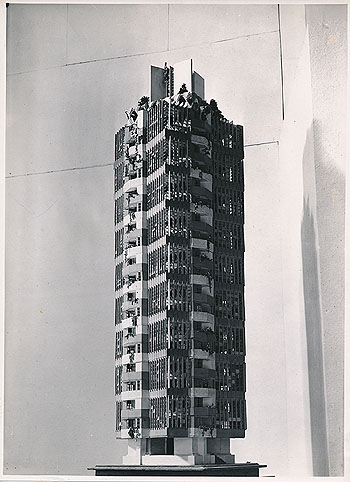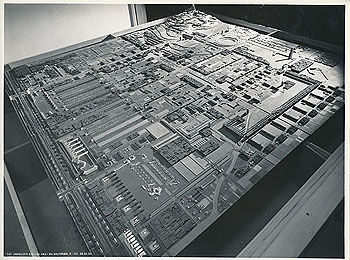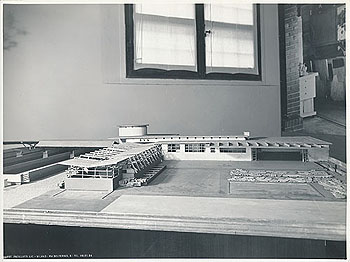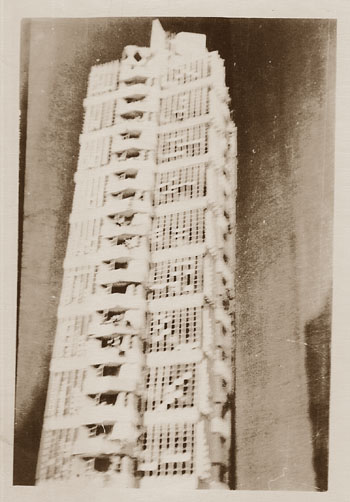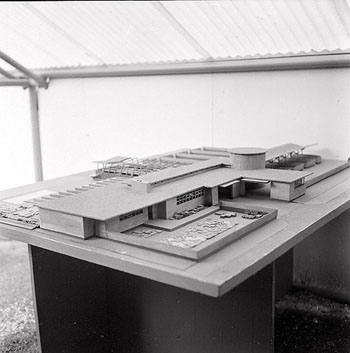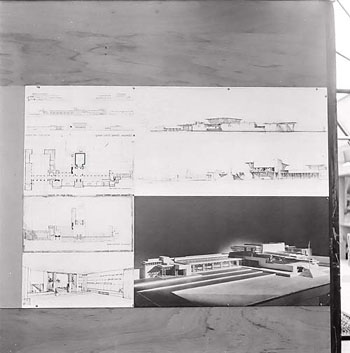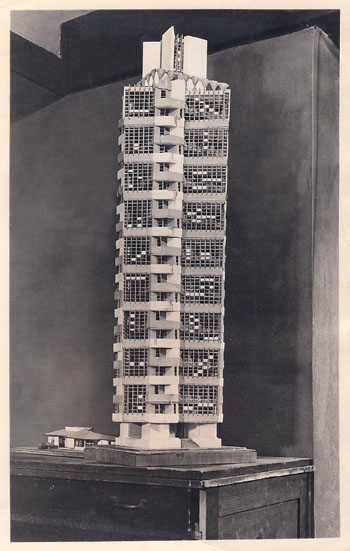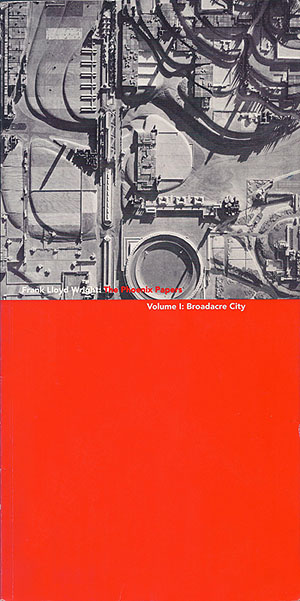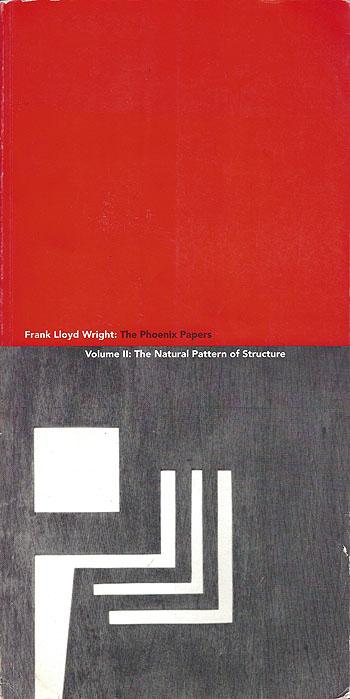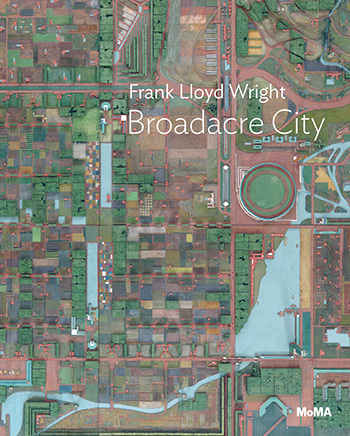
SUPPORT THE
WRIGHT LIBRARY
PROCEEDS FROM EVERY SALE GOES TO SUPPORT THE WRIGHT LIBRARY.
CLICK TO ORDER.
WE PROUDLY SUPPORT THE FRANK LLOYD WRIGHT FOUNDATION
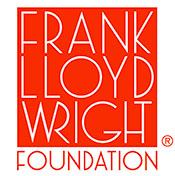
WE PROUDLY SUPPORT THE FRANK LLOYD WRIGHT BUILDING CONSERVANCY
WE PROUDLY SUPPORT FALLINGWATER
AND THE WESTERN PENNSYLVANIA CONSERVANCY

BROADACRE CITY
Broadacre City was a plan for a decentralized community that Wright promoted endlessly from the 1930s to his death in 1959. He believed that everyone should have at least an acre of land and the right to beautiful housing and carefully organized cities that were spread out, not like the congestion of places like New York, a town he insulted more than once. Broadacre was shown publically for the first time April 15 to May 15, 1935 at the Industrial Arts Exposition in Rockefeller Center, New York. It consisted of architectural models and a full model 12 by 12 feet in size, of Broadacre City itself, complete with tiny forests, homes, schools, factories, farms, and more!
HOUSE ON THE MESA Date: 1929 Title: St. Mark's Tower in the Bouwerie, circa 1929 (Project 1929).
Description: Perspective for apartment complex, designed in 1929 by Frank Lloyd Wright for his long time friend William Norman Guthrie, pastor of St. Mark's in the Bouwerie, New York. This was Wright's first use of his Taproot foundation design. A second tower in the complex can be seen to the right. It became the Broadacre model and later resurrected for the Price Tower. Illustration published in The New York Times Magazine, March 20, 1932, p.9.
Size: 5.75 x 10 B&W photograph.
S#: 0228.26.0115
Date: 1930 Title: St. Mark's Tower in the Bouwerie, circa 1929 (Project 1929).
Description: Published in Wasmuths Monatshefte - June 1930, in German by Ernst Wasmuth A-G, Berlin, Wien, Zurich. "Zwei Kleine Wolkenkratzer. Die Wolken Mussen schon ziemlich tief uber dem Michigansee hangen, wennm sie mit dem Hochhause der Bruder Bowman Kollidieren sollen, und dem Hause Frank Lloyd Wright's wird es mit seinem eigens in die Luft gereckten Vierzack auch schwerlich gelingen, Wolken zu kratzen..." Two Small Skyscrapers. The clouds must have been quite deep over Lake Michigan... An article about a skyscraper on Lake Michigan designed by the Bowman brothers, and the St. Mark's Tower in the Bouwerie project by Frank Lloyd Wright. Includes one illustration of St. Mark's Tower and two floor plans. Original cover price 3 RM. (Sweeney 249)
Size: 9.75 x 12.5
S#: 0249.00.0415
Date: 1929 Title: St. Mark's Tower in the Bouwerie (Project 1929).
Description: Side view and floor plan. Frank Lloyd Wright was commissioned in 1929 to design an apartment complex by his long term friend William Norman Guthrie, pastor of St. Mark's in the Bouwerie. This was Wright's first use of his Taproot foundation design. It became the Broadacre model and later resurrected for the Price Tower.
Size: Original 8 x 10 B&W photograph.
S#: 0228.22.0514
Date: 1929
Title: Vintage 4" x 3.25" Magic Lantern Slide of St. Mark's Tower in the Bouwerie, circa 1929 (Project 1929).
Description: Frank Lloyd Wright was commissioned in 1929 to design an apartment complex by his long time friend William Norman Guthrie, pastor of St. Mark’s in the Bouwerie. This was Wright’s first use of his Taproot foundation design. It became the Broadacre model and later resurrected for the Price Tower. Includes an illustration of a section and two floor plans, and a photograph of the model. Label affixed to face: “Wright, Frank Lloyd, 1867-1959. 1929. Project for St. Marks Tower. New York City; Plans, section and model. 48259L." Second small label: “Art. Dept. Smith College.” Acquired from the Art Department at Smith College.
Size: Magic lantern slide 4" x 3.25", Transparency: 2.5" x 2.6"
S#: 0228.41.1125
Left: St. Mark's Tower in the Bouwerie
Section and floor plans.
Right: St. Mark's Tower in the Bouwerie
model.Date: 1930 Title: Wright at the Art Institute of Chicago, September 24-25, 1930.
Description: Wright stands to the right of the St. Mark's in-the-Bouwerie Model on exhibition at the Art Institute of Chicago, 1930. In 1929 Frank Lloyd Wright designed a group of four towers for St. Mark's-in-the- Bouwerie, New York City (project). The design featured an innovative "tap root" structure, with the floors cantilevered off a vertical core. The traveling exhibition entitled "The Show" at the Art Institute of Chicago, September 25 - October 12, 1930. "The Show" exhibited in New York City; Chicago; Eugene, Oregon; Seattle, Washington; several European cities; and Milwaukee's Layton Gallery. It included 600 photographs, 1,000 drawings and four models (three of which were the Richard Lloyd Jones Residence, the Gas Station and St. Mark's-in-the-Bouwerie Towers). To the left is the Wright designed Skyscraper Vase. Designed and executed circa 1905, it appeared in photographs of Wright's 1907 exhibition at the Art Institute of Chicago and published in "The Early Work" 1968, page 101-103, and measured 22.5 x 6.125 x 3.5.
Size: 7 x 10 B&W photograph.
S#: 0249.37.0614
Date: 1930 Title: St. Mark's in-the-Bouwerie Model on exhibition at the Art Institute of Chicago, 1930.
Description: In 1929 Frank Lloyd Wright designed a group of four towers for St. Mark's-in-the-Bouwerie, New York City (project). The design featured an innovative "tap root" structure, with the floors cantilevered off a vertical core. The traveling exhibition entitled "The Show" at the Art Institute of Chicago, September 25 - October 12, 1930. "The Show" exhibited in New York City; Chicago; Eugene, Oregon; Seattle, Washington; several European cities; and Milwaukee's Layton Gallery. It included 600 photographs, 1,000 drawings and four models (three of which were the Richard Lloyd Jones Residence, the Gas Station and St. Mark's-in-the-Bouwerie Towers). To the left is the Wright designed Skyscraper Vase. Designed and executed circa 1905, it appeared in photographs of Wright's 1907 exhibition at the Art Institute of Chicago and published in "The Early Work" 1968, page 101-103, and measured 22.5 x 6.125 x 3.5.
Size: Original 7 x 7.5 B&W photograph.
S#: 0249.31.0913
Date: 1930 Title: Wright exhibition at the Layton Art Gallery, Milwaukee, Wisconsin, 1930.
Description: The exhibition opened late November 1930. St. Mark's in-the-Bouwerie Model (1929 project) is proximately featured, as is the Gas Station Model in the foreground. The Frank Lloyd Wright Foundation dates this project 1932, but it is seen here in 1930 (see Wright 1917-1942, Pfeiffer, pages 217-218). To the left is the Wright designed Skyscraper Vase. Designed and executed circa 1905, it appeared in photographs of Wright's 1907 exhibition at the Art Institute of Chicago and published in "The Early Work" 1968, page 101-103, and measured 22.5 x 6.125 x 3.5. Behind the vase on the left and right are the Nakomis (left) and Nakoma (right) Sculptures, designed in 1924, photographed in 1926. While Wright is setting up the display he is interviewed and is quoted on Nov. 20, 1930, in the Milwaukee Journal Sentinel, "It will take Milwaukee fully a century to recover from the influence of these buildings" (their new courthouse). A firestorm erupted in the Milwaukee press, which increased attendance at the exhibition. See "Layton's Legacy" 2013, pages 219-221.
Size: Original 6.25 x 8 B&W photograph.
S#: 0249.32.0913
Date: 1930
Title: New York Times Mid-Week Pictorial Magazine - December 20, 1930 (Mid-Week Pictorial is a weekly magazine published by The New York Times Company, Times Square, New York)
Description: Photograph of Frank Lloyd Wright in Milwaukee standing next to a model of St. Mark's Tower in the Bouwerie. Caption: "A Church Plans to Go in for Modernistic Architecture: Frank Lloyd Wright, Famous Architect, Exhibits in Milwaukee, a Scale Model of the Apartment House, Which He Has Designed for Erection on the Property of St. Mark's-in-the-Bouwerie, New York."
In 1929 Frank Lloyd Wright designed a group of four towers for St. Mark's-in-the-Bouwerie, New York City (project). The design featured an innovative "tap root" structure, with the floors cantilevered off a vertical core. The traveling exhibition entitled "The Show" at the Art Institute of Chicago, September 25 - October 12, 1930. "The Show" exhibited in New York City; Chicago; Eugene, Oregon; Seattle, Washington; several European cities; and Milwaukee's Layton Gallery. It included 600 photographs, 1,000 drawings and four models (three of which were the Richard Lloyd Jones Residence, the Gas Station and St. Marks-in-the-Bouwerie Towers). Original cover price 10c.
Size: 11.5 x 15
Pages: Pp 13
S#: 0249.63.0723Date: 1932
Title: Broadacre City, Standardized Gas Station, Perspective, 1932, (Project FLLW #3202).
Description: Standardized Gas Station. Frank Lloyd Wright, Architect. First designed by Frank Lloyd Wright in 1932. Original perspective published in Wright 1917-1942, Pfeiffer, 2010, p.217. In 1934 it was incorporated into Broadacre City. Published in The Living City, Wright, 1958, p.118-119. In 1956 it was redesigned as the Lindholm Service Station (1956 - S. 414). Text on sleeve: "Wright, F. L. - Broadacre City - Service Station. 3-1. Overhead Service Station Project. Render ., Perspective drawing. 1924-29. Broadacre City Project. Wright, Frank Lloyd. U of Virginia FAIC." Acquired from the archives of the University of Virginia.
Size: 35mm Color slide, sandwiched between glass, plastic mount.
S#: 0361.14.0420Date: 1932
Title: Broadacre City, Standardized Gas Station, Ground Level Plan, 1932, (Project FLLW #3202).
Description: Standardized Gas Station. Frank Lloyd Wright, Architect. First designed by Frank Lloyd Wright in 1932. In 1934 it was incorporated into Broadacre City. Published in The Living City, Wright, 1958, p.120. In 1956 it was redesigned as the Lindholm Service Station (1956 - S. 414). Text on sleeve: "Wright, F. L. - Broadacre City - Service Station. 1-1. Overhead Service Station Project. Plan, Ground level. 1924-29. Broadacre City Project. Wright, Frank Lloyd. U of Virginia FAIC." Acquired from the archives of the University of Virginia.
Size: 35mm Color slide, sandwiched between glass, plastic mount.
S#: 0361.15.0420Date: 1932
Title: Broadacre City, Standardized Gas Station, Upper Level Plan, 1932, (Project FLLW #3202).
Description: Standardized Gas Station. Frank Lloyd Wright, Architect. First designed by Frank Lloyd Wright in 1932. In 1934 it was incorporated into Broadacre City. Published in The Living City, Wright, 1958, p.120. In 1956 it was redesigned as the Lindholm Service Station (1956 - S. 414). Text on sleeve: "Wright, F. L. - Broadacre City - Service Station. 1-1. Overhead Service Station Project. Plan, Upper level. 1924-29. Broadacre City Project. Wright, Frank Lloyd. U of Virginia FAIC." Acquired from the archives of the University of Virginia.
Size: 35mm Color slide, sandwiched between glass, plastic mount.
S#: 0361.16.0420Date: 1932
Title: Broadacre City, Unified Farm Project, Perspective, 1932, (Project FLLW #3202).
Description: The Unified Farm. Frank Lloyd Wright, Architect. First designed as the Walter V. Davidson "The Unified Farm," Prefabricated Farm Unit by Frank Lloyd Wright in 1932. The house and farm were designed as a complete single unit, all under one room. Original perspective published in Wright 1917-1942, Pfeiffer, 2010, p.216. In 1934 it was incorporated into Broadacre City. Published in The Living City, Wright, 1958, p.61. Text on sleeve: "Wright, F. L. - Broadacre City - Unified Farm. 1-1. Unified Farm Project. Persp. dwg. from above. 1924-29. Broadacre City Project. Wright, Frank Lloyd. U of Virginia FAIC." Acquired from the archives of the University of Virginia.
Size: 35mm Color slide, sandwiched between glass, plastic mount.
S#: 0361.12.0420Date: 1932
Title: Broadacre City, Unified Farm Project, Plan, 1932, (Project FLLW #3202).
Description: Plan for Unified Farm. Frank Lloyd Wright, Architect. First designed as the Walter V. Davidson "The Unified Farm," Prefabricated Farm Unit by Frank Lloyd Wright in 1932. The house and farm were designed as a complete single unit, all under one room. Original plan published in Wright 1917-1942, Pfeiffer, 2010, p.216. In 1934 it was incorporated into Broadacre City. Published in The Living City, Wright, 1958, p.60. Text on sleeve: "Wright, F. L. - Broadacre City - Unified Farm. 1-1. Unified Farm Project. Plan. 1924-29. Broadacre City Project. Wright, Frank Lloyd. U of Virginia FAIC." Acquired from the archives of the University of Virginia.
Size: 35mm Color slide, sandwiched between glass, plastic mount.
S#: 0361.13.0420Date: 1932
Title: Broadacre City, Roadside Market, Perspective, 1932, (Project FLLW #3202).
Description: The Roadside Market. Frank Lloyd Wright, Architect. First designed as the Davidson Wayside Market by Frank Lloyd Wright in 1932. Original perspective published in Wright 1917-1942, Pfeiffer, 2010, p.215. In 1934 it was incorporated into Broadacre City. Published in The Living City, Wright, 1958, p.99. Text on sleeve: "Wright, F. L. - Broadacre City - Roadside Market. 3-1. Roadside Market Project. Render., Perspective Sketch. 1924-29. Broadacre City Project. Wright, Frank Lloyd. U of Virginia FAIC." Acquired from the archives of the University of Virginia.
Size: 35mm Color slide, sandwiched between glass, plastic mount.
S#: 0361.17.0420Date: 1932
Title: Broadacre City, Roadside Market, Elevation, 1932, (Project FLLW #3202).
Description: The Roadside Market. Frank Lloyd Wright, Architect. First designed as the Davidson Wayside Market by Frank Lloyd Wright in 1932. Original Plan published in Wright 1917-1942, Pfeiffer, 2010, p.216. In 1934 it was incorporated into Broadacre City. Published in The Living City, Wright, 1958, p.100. Text on sleeve: "Wright, F. L. - Broadacre City - Roadside Market. 2-2. Roadside Market Project. Elev. 1924-29. Broadacre City Project. Wright, Frank Lloyd. U of Virginia FAIC." Acquired from the archives of the University of Virginia.
Size: 35mm Color slide, sandwiched between glass, plastic mount.
S#: 0361.18.0420Date: 1932
Title: Broadacre City, Roadside Market, Section, 1932, (Project FLLW #3202).
Description: The Roadside Market. Frank Lloyd Wright, Architect. First designed as the Davidson Wayside Market by Frank Lloyd Wright in 1932. Original Section published in Wright 1917-1942, Pfeiffer, 2010, p.216. In 1934 it was incorporated into Broadacre City. Published in The Living City, Wright, 1958, p.100. Text on sleeve: "Wright, F. L. - Broadacre City - Roadside Market. 2-1. Roadside Market Project. Sect. 1924-29. Broadacre City Project. Wright, Frank Lloyd. U of Virginia FAIC." Acquired from the archives of the University of Virginia.
Size: 35mm Color slide, sandwiched between glass, plastic mount.
S#: 0361.19.0420Date: 1932
Title: Broadacre City, Roadside Market, Plan, 1932, (Project FLLW #3202).
Description: The Roadside Market. Frank Lloyd Wright, Architect. First designed as the Davidson Wayside Market by Frank Lloyd Wright in 1932. Original Section published in Wright 1917-1942, Pfeiffer, 2010, p.216. In 1934 it was incorporated into Broadacre City. Published in The Living City, Wright, 1958, p.101. Text on sleeve: "Wright, F. L. - Broadacre City - Roadside Market. 1-1. Roadside Market Project. Plan. 1924-29. Broadacre City Project. Wright, Frank Lloyd. U of Virginia FAIC." Acquired from the archives of the University of Virginia. 35mm Color slide, sandwiched between glass, plastic mount.
Size: 35mm Color slide, sandwiched between glass, plastic mount.
S#: 0361.20.0420Date: 1933
Title: Decorative Art. The Studio Year Book (Hard Cover) (Published by The Studio Limited, London, and The Studio Publications, Inc., New York)
Author: Edited By: Holme, C. G.
Description: "Students of this Year Book cannot failed to have noticed within the last few years many great changes and improvements in the design of the objects we produced in its pages. Greater simplicity, efficiency and attractiveness characterize the industrial products that have been selected, and change is especially noticeable in these industrially produced articles..." Includes one photograph of the model for The House On The Mesa (Broadacre City). Caption: "Frank Lloyd Wright, architect, New York. Model of house on the Mesa, designed for a moderately wealthy American family and servants. Construction of reinforced concrete, glass and copper, the style dictated by constructional necessity and human convenience. Distinctive features are the great sun loggia on the ground floor and the roof terraces. Rooms giving on to the loggia and roof are screened from the wind by perforated copper screens. Indoor rooms are in groups: family living-rooms, guest-rooms, children and servants quarters, kitchen, etc. Ample space is provided in the garage courtyard, which is surrounded by rooms for servants, chauffeurs and gardeners, for both family and visiting cars." (P.28) (First Edition)
Size: 8 x 11.5
Pages: Pp 140
S#: 0370.16.0319Date: 1934
Title: Broadacre City, Cottage For Level Ground, Perspective, Circa 1934.
Description: Perspective view of the Typical Cottage for Level Ground, designed by Frank Lloyd Wright. Published in The Living City, Wright, 1958, p.62. Text on sleeve: "Wright, F. L. - Broadacre City - Cottage. 3-1. Cottage for Level Ground (Prefabrication) model. 1924-29. Broadacre City Project. Wright, Frank Lloyd. U of Virginia FAIC." Acquired from the archives of the University of Virginia.
Size: 35mm Color slide, sandwiched between glass, plastic mount.
S#: 0376.11.0420Date: 1934
Title: Broadacre City, Usonian Concrete Block House, Perspective, Circa 1934.
Description: Perspective view of the Usonian Concrete Block House designed by Frank Lloyd Wright. Published in The Living City, Wright, 1958, p.70. Text on sleeve: "Wright, F. L. - Broadacre City - Usonian House . 3-1. Usonian Concrete Block House Project. Render., Perspective drawing. 1924-29. Broadacre City Project. Wright, Frank Lloyd. U of Virginia FAIC." Acquired from the archives of the University of Virginia.
Size: 35mm Color slide, sandwiched between glass, plastic mount.
S#: 0376.07.0420Date: 1934
Title: Broadacre City, Usonian Concrete Block House, Living Room Perspective, Circa 1934.
Description: Perspective view of the Usonian Concrete Block House Living Room designed by Frank Lloyd Wright. Published in The Living City, Wright, 1958, p.70. Text on sleeve: "Wright, F. L. - Broadacre City - Usonian House . 3-2. Usonian Concrete Block House Project. Render., Interior Living Room perspective drawing. 1924-29. Broadacre City Project. Wright, Frank Lloyd. U of Virginia FAIC." Acquired from the archives of the University of Virginia.
Size: 35mm Color slide, sandwiched between glass, plastic mount.
S#: 0376.08.0420Date: 1934
Title: Broadacre City, Usonian Concrete Block House, Ground Plan, Circa 1934.
Description: Ground Plan for the Usonian Concrete Block House designed by Frank Lloyd Wright. Published in The Living City, Wright, 1958, p.71. Text on sleeve: "Wright, F. L. - Broadacre City - Usonian House . 1-1. Usonian Concrete Block House Project. Plan Ground Floor. 1924-29. Broadacre City Project. Wright, Frank Lloyd. U of Virginia FAIC." Acquired from the archives of the University of Virginia.
Size: 35mm Color slide, sandwiched between glass, plastic mount.
S#: 0376.09.0420Date: 1934
Title: Broadacre City, Usonian Concrete Block House, Upper Level Plan, Circa 1934.
Description: Upper Level Plan for the Usonian Concrete Block House designed by Frank Lloyd Wright. Published in The Living City, Wright, 1958, p.71. Text on sleeve: "Wright, F. L. - Broadacre City - Usonian House . 1-1. Usonian Concrete Block House Project. Plan Upper Level. 1924-29. Broadacre City Project. Wright, Frank Lloyd. U of Virginia FAIC." Acquired from the archives of the University of Virginia.
Size: 35mm Color slide, sandwiched between glass, plastic mount.
S#: 0376.10.0420Date: 1935 Title: Broadacre City. Frank Lloyd Wright and apprentices working on Broadacre City model, 1935.
Description: On January 23, 1935, the Taliesin Fellowship left en masse to start their trek to Arizona. This was pre Taliesin West, so their destination was La Hacienda in Chandler. "In the courtyard of our Hacienda the master and his apprentices are working on the model of Broadacre City. The model comprising an area of 12 square feet is placed at the head of the court and around it the apprentices have grouped their drafting tables..." Cornella Brierly, February 24, 1935, in "At Taliesin", Henning, 1992, p.111. Published in "Tales of Taliesin", Brierly, 1996, p.27. Left to right around the model: Burt Goodrich, Edgar Kaufmann, Jr., Blaine Drake, Benny Dombar, Abe Dombar, John Lautner, Jim Thomson, Edgar Tafel, Alfie Bush, Bruce Richards, Jack Howe, Karl Monrad, Mr. Wright, Will Schwanke, Gene Masselink, Bob Bishop, Bill Bernoudy. Broadacre was shown publically for the first time April 15 to May 15, 1935 at the Industrial Arts Exposition in Rockefeller Center, New York. It consisted of architectural models and a full model 12 by 12 feet in size, of Broadacre City itself, complete with tiny forests, homes, schools, factories, farms, and more.
Size: 10 x 6.5 B&W photograph.
S#: 0397.29.0215
Date: 1935 Title: Broadacre City. Cornelia Brierly working on Broadacre City model, 1935.
Description: On January 23, 1935, the Taliesin Fellowship left en masse to start their trek to Arizona. This was pre Taliesin West, so their destination was La Hacienda in Chandler. "In the courtyard of our Hacienda the master and his apprentices are working on the model of Broadacre City. The model comprising an area of 12 square feet is placed at the head of the court and around it the apprentices have grouped their drafting tables..." Cornella Brierly, February 24, 1935, in "At Taliesin", Henning, 1992, p.111. Published in "Tales of Taliesin", Brierly, 1996, p.25. Brierly (Left), Benny Dombar (right), Will Schwanke (back). Broadacre was shown publically for the first time April 15 to May 15, 1935 at the Industrial Arts Exposition in Rockefeller Center, New York. It consisted of architectural models and a full model 12 by 12 feet in size, of Broadacre City itself, complete with tiny forests, homes, schools, factories, farms, and more.
Size: 10 x 6.5 B&W photograph.
S#: 0397.30.0215
Date: 1935 Title: Broadacre City. Frederick Langhorst working on Broadacre City model, 1935.
Description: On January 23, 1935, the Taliesin Fellowship left en masse to start their trek to Arizona. This was pre Taliesin West, so their destination was La Hacienda in Chandler. "In the courtyard of our Hacienda the master and his apprentices are working on the model of Broadacre City. The model comprising an area of 12 square feet is placed at the head of the court and around it the apprentices have grouped their drafting tables..." Cornella Brierly, February 24, 1935, in "At Taliesin", Henning, 1992, p.111. Published in "At Taliesin", p.130. Broadacre was shown publically for the first time April 15 to May 15, 1935 at the Industrial Arts Exposition in Rockefeller Center, New York. It consisted of architectural models and a full model 12 by 12 feet in size, of Broadacre City itself, complete with tiny forests, homes, schools, factories, farms, and more.
Size: 10 x 7.5 B&W photograph.
S#: 0397.31.0215
Date: 1935 Title: Broadacre City. Apprentices working on Broadacre City model in the La Hacienda courtyard, 1935.
Description: On January 23, 1935, the Taliesin Fellowship left en masse to start their trek to Arizona. This was pre Taliesin West, so their destination was La Hacienda in Chandler. "In the courtyard of our Hacienda the master and his apprentices are working on the model of Broadacre City. The model comprising an area of 12 square feet is placed at the head of the court and around it the apprentices have grouped their drafting tables..." Cornella Brierly, February 24, 1935, in "At Taliesin", Henning, 1992, p.111. Broadacre was shown publically for the first time April 15 to May 15, 1935 at the Industrial Arts Exposition in Rockefeller Center, New York. It consisted of architectural models and a full model 12 by 12 feet in size, of Broadacre City itself, complete with tiny forests, homes, schools, factories, farms, and more.
Size: 10 x 7.5 B&W photograph.
S#: 0397.32.0215
Date: 1935 Title: St. Mark's Tower (project) 1935.
Description: Cornelia Brierly with the St. Mark's Tower model at the Kaufmann Department Store, Pittsburgh. It became part of the Broadacre City traveling exhibition. Brierly attended the exhibitions at the Kaufmann Department Store and Corcoran Gallery in Washington D.C., talking with thousands of visitors each day, explaining Wright's concepts of decentralization. Broadacre was shown publically for the first time from April 15 to May 15, 1935 at the Industrial Arts Exposition in Rockefeller Center, New York. It was next exhibited in the museum of the State Historical Library in Madison, Wisconsin. From there it went to Kaufmann's Department Store in Pittsburg, Kaufmann being Broadacre's benefactor. It next moved to Corcoran Gallery in Washington D.C., made possible by Mrs. Avery Coonley. It headed back to Taliesin then was displayed at the Mineral Point Iowa County Fair in September. Photographed by N. M. Jeannero, Pittsburgh Post Gazette.
Size: Original 7.5 x 9.5 B&W photograph.
S#: 0397.20.0913
Date: 1935 Title: Broadacre City, John Howe stands next to section of Broadacre City, circa March 1935.
Description: John Henry Howe was born in 1913 in Evanston, Illinois. In 1932, a week after completing high school, he left to join Frank Lloyd Wright, who was forming the Taliesin Fellowship in Spring Green, Wisconsin. By 1937, Howe became Wright's chief-draftsman. For more than twenty years, John Howe was known as "the pencil in Frank Lloyd Wright's hand." How worked with Wright for 27 years. He then continued as one of the Taliesin Associated architects for another five years, when he left to form his own architectural firm. On January 23, 1935, the Taliesin Fellowship left en masse to start their trek to Arizona. This was pre Taliesin West, so their destination was La Hacienda in Chandler. "In the courtyard of our Hacienda the master and his apprentices are working on the model of Broadacre City. The model comprising an area of 12 square feet is placed at the head of the court and around it the apprentices have grouped their drafting tables..." Cornella Brierly, February 24, 1935, in "At Taliesin", Henning, 1992, p.111. Published in "At Taliesin", p.133, caption: "Broadacre City Model, Section A... apprentice John Howe proudly beside a finished section of the four-part, twelve-foot-square model; La Hacienda courtyard, Chandler, AZ). Photo courtesy of John H. Howe, Architect." Broadacre was shown publically for the first time April 15 to May 15, 1935 at the Industrial Arts Exposition in Rockefeller Center, New York. It consisted of architectural models and a full model 12 by 12 feet in size, of Broadacre City itself, complete with tiny forests, homes, schools, factories, farms, and more.
Size: Original 8 x 10 B&W photograph.
S#: 0397.28.0215
Date: 1935
Title: Vintage 4" x 3.25" Magic Lantern Slide of Broadacre City Model and plan, 1935 (FLLW#3402).
Description: Model and partial floor plan of Broadacre City, designed by Frank Lloyd Wright in 1932. This Model was exhibited at the Broadacre Exhibition held at the Industrial Arts Exhibition, New York, held in 1935. Label affixed to face: “Wright, Frank Lloyd, 1867-1959. c.1932. Project: Broadacre City: plan and model. 20252L. Art. Dept. Smith College.” Acquired from the Art Department at Smith College.
Size: Magic lantern slide 4" x 3.25", Transparency: 3" x 2"
S#: 0361.31.1125
Left: Model of Broadacre City.
Left: Partial floor plan of Broadacre City.Date: 1935
Title: Vintage 4" x 3.25" Magic Lantern Slide of Broadacre City Model, 1935 (FLLW#3402).
Description: Model of Broadacre City, designed by Frank Lloyd Wright in 1932. This Model was exhibited at the Broadacre Exhibition held at the Industrial Arts Exhibition, New York, held in 1935. Label affixed to face: “Wright, Frank Lloyd, 1867-1959. c.1932. Project: Broadacre City: model. 31715L. Art. Dept. Smith College.” Acquired from the Art Department at Smith College.
Size: Magic lantern slide 4" x 3.25", Transparency: 3" x 2"
S#: 0361.32.1125
Left: Model of Broadacre City.Date: 1935 Title: Broadacre City model quarter section, 1935.
Description: Broadacre was shown publically for the first time April 15 to May 15, 1935 at the Industrial Arts Exposition in Rockefeller Center, New York. It consisted of architectural models and a full model 12 by 12 feet in size, of Broadacre City itself, complete with tiny forests, homes, schools, factories, farms, and more. Text on the board in the background: "A New Freedom. An acre of ground minimum for the individual. Broadacre makes no change in existing system of land surveys. Has a single seat of government for each county administration by radio and aerotor. Architectural features determined by the character and typography of the region. No major or minor axis." Courtesy of The Frank Lloyd Wright Foundation.
Size: 10 x 8 B&W photograph.
S#: 0397.27.1214
Date: 1935
Title: Broadacre City, 1935. Frank Lloyd Wright studies model of Broadacre City at the Rockefeller Center, New York on April 15, 1935.
Description: Broadacre was shown publically for the first time April 15 to May 15, 1935 at the Industrial Arts Exposition in Rockefeller Center, New York. It consisted of architectural models and a full size 12' by 12' model of Broadacre City itself, complete with forests, homes, schools, factories, farms, and more. In the background to the right is the House on a Mesa, 1931. Photographed on April 15, 1935 by Keystone View Company.
Size: 10 x 8 B&W photograph.
S#: 0397.39.0117Date: 1935
Title: Broadacre City Model Detail of Stadium, 1935.
Description: Detail of the Broadacre City Stadium within the 12 foot by 12 foot model of Broadacre City. Broadacre was shown publically for the first time April 15 to May 15, 1935 at the Industrial Arts Exposition in Rockefeller Center, New York. Published in Frank Lloyd Wright, The Living City, Wright, 1958, p.103.
Size: 10 x 6 B&W photograph.
S#: 0397.40.0117
Wright handwritten note on verso Date: 1935 Title: Broadacre City, 1935. Model Homes.
Description: Photographed by Dan Keller, Seidman Photo Service, New York. Caption on verso, handwritten by Frank Lloyd Wright reads "Collateral Detail Model: A Two Car House , Two Minimum Houses and a Medium House." Verification, Kelmscott Galleries; Leslie Hindman Auctioneers 1990, page 41 item 143; Additional analysis "Frank Lloyd Wright and the Living City" De Long 1998, page 29. As with the 1938 and 1948 Architectural Forum issues which Wright designed, wrote and coordinated, details such as captions and photo selection were handled by Wright. Published in Architectural Record, April 1935 page 247; Junior Red Cross Journal, Feb 1936, page 137. Caption in Architectural Record "Collateral Detail Models: A Two Car House (right), Two Minimum Houses (center) and a Medium House (left)." Exhibited at the Industrial Arts Exhibition, Rockefeller Center, New York, April 15 - May 15, 1935.
Size: Original 8 x 10 vintage silver gelatin photograph
0393.02.0107
Wright handwritten note on verso Date: 1935 Title: Broadacre City, 1935. Model Bridge.
Description: Photographed by Dan Keller, Seidman Photo Service, New York. Caption on verso, handwritten by Frank Lloyd Wright reads "Bridge Over Great Arterial Right of Way, Which Consists of Many Lanes of Speed Traffic Above, Monorail Speed Trains In the Middle, and Truck and Traffic on Lower Side Lanes. Within the Highway Structures are Storage Facilities for Raw Material." Verification, Kelmscott Galleries; Leslie Hindman Auctioneers 1990, page 41 item 143; Additional analysis "Frank Lloyd Wright and the Living City" De Long 1998, page 29. As with the 1938 and 1948 Architectural Forum issues which Wright designed, wrote and coordinated, details such as captions and photo selection were handled by Wright. Published in Architectural Record, April 1935 page 246.
Size: Original 8 x 10 vintage silver gelatin photograph
0393.03.0107
Date: 1935
Title: Edgar Tafel. The Small House in Broadacre City. Circa 1935.
Description: Carbon Copy of an article written by Edgar Tafel. Construction of the Broadacre model begin in November 1934. It was crafted by the apprentices who worked with him at Taliesin. It was financed by Edgar Kaufmann. Broadacre City was shown publically for the first time April 15 to May 15, 1935 at the Industrial Arts Exposition in Rockefeller Center, New York. It consisted of architectural models and a full model 12 by 12 feet in size, of Broadacre City itself, complete with tiny forests, homes, schools, factories, farms, and more. Kaufmann then arranged to have the model displayed in Pittsburgh. The exposition opened on June 18 on the 11th floor of Kaufmann's store.
The Small House in Broadacre City.
In the past, the small house that attempted to solve the low cost housing need, was an attempt to copy almost anything that wasn't in its own price class. In Europe, the architects squeezed bits of the large features of the expensive houses, into a scrawney (sic) meager homestead. The Internationalists designed boxes, supplying the cold bare necessities. In America, the "subsistence" crime is quite evident. The houses are neither cheap enough, nor made in fulfillment of their needs. They still copy the colonial, the five-holed facade still exists, the ornament is still there-but more scarce. They are building a cheap house. The owner knows he owns a cheap house, and knows its depreciation. The old building methods don't fit the new need.
The Broadacre City small house-or minimum house-is designed with large scale prefabrication production in mind-and this does not mean repetition. The house is planned on a convenient unit system and size, simple enough in setup so that any craftsman couldn't go wrong. With this unit of construction, an inexpensive house can be built to fit an individual need.
A large portion of the cost of the small house is eliminated by a standardized central utility stack, which provides the house with heater, kitchen and bath appurtenances. This is the only part of the minimum house that is necessarily uniform throughout the Broadacre City. Otherwise, the small houses are unlimited in design. There are three roof types; the Gable, Hip, and Flat. The flat roof is intended for the plains, but up on the slopes, the Pitched roof house will lend itself to the different geological condition. The minimum house, after built, is still capable of being enlarged by adding units of construction.
At last, the owner of the low cost house can be proud of his home. For it is straightforward, simple, according to his means, and has every feeling of the home. His children sleep in the open sleeping porch and dress in their individual closets. The master has his own workshop, and garage nearby. The kitchen is light and airy, removed from the living room by a low screen. The total area of the house is small, the sense of space is unlimited. The quality of materials is as fine as in any of the larger houses. Essentially the only difference between the Broadacre large and small houses, is size, not quality.
Edgar A. Tafel
Two pages. Acquired from the estate of Cary Caraway.
Size: 8.5 x 11.
S#: 0397.57.0720Date: 1940
Title: Broadacre City Model, Aerial View 1940 (1934 - FLLW #3402).
Description: Aerial view of architect Frank Lloyd Wright's model of Broadacre City, exhibited at The Museum of Modern Art in 1940. Broadacre City was a plan for a decentralized community that Wright promoted endlessly from the 1930s to his death in 1959. He believed that everyone should have at least an acre of land and the right to beautiful housing and carefully organized cities that were spread out, not like the congestion of places like New York, a town he insulted more than once. Frank Lloyd Wright first introduced Broadacre City in The Disappearing City, 1932. In 1934, with the aid of his apprentices, Wright brought Broadacre City of life in a 12' x 12' model shown publically for the first time April 15 to May 15, 1935 at the Industrial Arts Exposition in Rockefeller Center, New York. It consisted of architectural models, complete with tiny forests, homes, schools, factories and farms.
In 1940, The Museum of Modern Art exhibited "Frank Lloyd Wright, American Architect", organized by the museum and frank Lloyd Wright. It ran from November 13, 1940 - January 5, 1941. Wright coined it "The Show to End all Shows." It included drawings, photostats photographs, models and descriptive panels, and included the complete Broadacre City model and four individual Broadacre models.
Wright also published "The New Frontier, Broadacre City" for the show. "For five months the Fellowship devoted its energies to the models illustrated here and is refreshing them all for exhibition this coming November at the Museum of Modern Art, New York City."
In this photograph, the numbers are actually affixed to the surface of the photograph. Partial clipping taped to the verso: "1. Multiple Lane Highway Which Connects Broadacre City with the Outside World. 2. Small Factories Provide Small Targets Attacking Bombers in Case of War. 3. ...sons on Each, Are Located on Ourskirts. 4. Skyscraper Apartments Contain Living Quarters for 32 Families, Are 160 Ft... 6. A Small High School, in the Center of Broadacres, Is Very Easily Accessible..." Hand written on verso: Frank Lloyd Wright. Broadacre City. Dec 22/40.
Size: Original 10.75 x 6 B&W photograph.
S#: 0531.112.1223Date: 1951
Title: Sixty Years of Living Architecture, Palazzo Strozzi, Florence, 1951.
Description: Display #47: "St. Mark's Tower, New York City, 1929. Model, two-story apartments; built of copper, glass and concrete; constructed with a central core and cantilevered floor slabs." Part of a set of forty B&W photographs by Ancillotti & Co., of the exhibition "Sixty Years of Living Architecture" held in Florence, Italy, 1951. "Sixty Years of Living Architecture: The Work of Frank Lloyd Wright" was a traveling exhibition of Wright's work, consisting of models, large photographs and original drawings. A Preview of the exhibition was held in Philadelphia at Gimbel Brothers Gallery in January, 1951. The world wide tour opened in Palazzo Strozzi Florence, Italy in June, 1951. Ancillotti & Company photographed many of the models and also documented the large photographs that were on display.
Size: Original 7.25 x 9 B&W photograph.
S#: 0857.51.0221 -9Date: 1951
Title: Sixty Years of Living Architecture, Palazzo Strozzi, Florence, 1951.
Description: Display #51: "Broadacre City. Model. A conception of the ideal modern decentralized community. Scale of the model: 4 square miles. This area includes 2200 one-acre plots. Protesting against the exaggerated and inhuman concentration in American cities, Broadacre City is designed for the direct contact of man with nature and the countryside. His birthright is re-established; the wide, open spaces are apparently built upon. Thus the "urbanized countryside" is born as a new type of city - one adapted to individual living." Text bottom left: "Fot. Ancillotti & C. - Milano - Via Solferino, 3 - Tel. 89.85.84." Part of a set of forty B&W photographs by Ancillotti & Co., of the exhibition "Sixty Years of Living Architecture" held in Florence, Italy, 1951. "Sixty Years of Living Architecture: The Work of Frank Lloyd Wright" was a traveling exhibition of Wright's work, consisting of models, large photographs and original drawings. A Preview of the exhibition was held in Philadelphia at Gimbel Brothers Gallery in January, 1951. The world wide tour opened in Palazzo Strozzi Florence, Italy in June, 1951. Ancillotti & Company photographed many of the models and also documented the large photographs that were on display.
Size: Original 9 x 7.25 B&W photograph.
S#: 0857.51.0221 -10Date: 1951
Title: Sixty Years of Living Architecture, Palazzo Strozzi, Florence, 1951.
Description: Display #52: "Farm Unit, Broadacre City, 1932. Prefabricated steel construction model." Text bottom left: "Fot. Ancillotti & C. - Milano - Via Solferino, 3 - Tel. 89.85.84." Part of a set of forty B&W photographs by Ancillotti & Co., of the exhibition "Sixty Years of Living Architecture" held in Florence, Italy, 1951. "Sixty Years of Living Architecture: The Work of Frank Lloyd Wright" was a traveling exhibition of Wright's work, consisting of models, large photographs and original drawings. A Preview of the exhibition was held in Philadelphia at Gimbel Brothers Gallery in January, 1951. The world wide tour opened in Palazzo Strozzi Florence, Italy in June, 1951. Ancillotti & Company photographed many of the models and also documented the large photographs that were on display.
Size: Original 9 x 7.25 B&W photograph.
S#: 0857.51.0221 -11Date: 1953 Title: Sixty Years of Living Architecture Exhibition, 1) #47: St. Mark's Tower Model, New York City, 1929.
Description: During the summer of 1935 Wright and his apprentices constructed a 12 foot square model of Broadacre City, including the large model of St. Mark's Tower (1929 project), consisting of two-story apartments, built of copper, glass and concrete, constructed with a central core and cantilevered floor slabs. This model was exhibited in 1940, at the MOMA exhibited "Frank Lloyd Wright, American Architect". Photograph of model is published in "Frank Lloyd Wright / Sixty Years of Living Architecture" (Zurich), 1952, page 24, "Frank Lloyd Wright: 60 Jabre Architektur" (Germany) 1952, page 33, and "The Future of Architecture" Wright, 1953, page 271. This later became the Price Tower (1952 - S.355).
Size: 3.25 x 4.5 sepia tone photograph, faded and out of focus.
S#: 0987.49.0813
Date: 1954
Title: Sixty Years of Living Architecture Exhibition, Los Angeles 1954 (Frank Lloyd Wright Foundation project #5427).
Description: A traveling exhibition of Wright's work, consisting of models, photographs and original drawings. A Preview of the exhibition was held in Philadelphia (January 1951). The world wide tour opened in Palazzo Strozzi Florence, Italy (June 1951). In "Sixty Years" (New York), Wright notes that from Florence the Exhibition traveled to "Switzerland, France, German and Holland". The Exhibition catalogs are dated: Paris (April 1952), Zurich (End of May 1952), Munich (May 16 - June 15, 1952), and Rotterdam (dated June 1, 1952). After two years in Europe the exhibition crossed the Atlantic to Mexico City, then to New York (1953). After an exhibition in Los Angeles, June, 1954, the final exhibition took place in Chicago, October, 1956. The Los Angeles exhibition premiere was held at Barnsdall Park's Municipal Art Center on June 1, 1954, then open to the public from June 2 to July 11, and was extended to July 25, 1954. A temporary pavilion, similar to the pavilion in New York, was attached to the line of kennels that reached from the house to the garage. Exhibition Model #52. "Farm Unit, Broadacre City, 1932. Prefabricated steel construction model." Sixty Years of Living Architecture Exhibition, Los Angeles 1954. Photographed by Loch Crane in June, 1954.
Size: B&W 2.25" negative, high res scan, and 8 x 8 B&W photograph
S#: 1045.42.1116-8Date: 1954
Title: Sixty Years of Living Architecture Exhibition, Los Angeles 1954 (Frank Lloyd Wright Foundation project #5427).
Description: A traveling exhibition of Wright's work, consisting of models, photographs and original drawings. A Preview of the exhibition was held in Philadelphia (January 1951). The world wide tour opened in Palazzo Strozzi Florence, Italy (June 1951). In "Sixty Years" (New York), Wright notes that from Florence the Exhibition traveled to "Switzerland, France, German and Holland". The Exhibition catalogs are dated: Paris (April 1952), Zurich (End of May 1952), Munich (May 16 - June 15, 1952), and Rotterdam (dated June 1, 1952). After two years in Europe the exhibition crossed the Atlantic to Mexico City, then to New York (1953). After an exhibition in Los Angeles, June, 1954, the final exhibition took place in Chicago, October, 1956. The Los Angeles exhibition premiere was held at Barnsdall Park's Municipal Art Center on June 1, 1954, then open to the public from June 2 to July 11, and was extended to July 25, 1954. A temporary pavilion, similar to the pavilion in New York, was attached to the line of kennels that reached from the house to the garage. Exhibition Panel #140. "House on the Mesa, 1931." Six drawings and one photograph of the of the House on the Mesa model. Frank Lloyd Wright design the house for MOMA's 1932 Modern Architecture: International Exhibition. It then was incorporated into Wright's Broadacre City as a model for upper-class housing. Photographed by Loch Crane in June, 1954.
Size: B&W 2.25" negative, high res scan, and 8 x 8 B&W photograph
S#: 1045.42.1116-41Date: 1963 Title: Broadacre City, City Dweller's Unit
Description: Broadacre City, City Dweller's Unit, Broadacre City Model, 1963. Caption pasted to verso: "City Dweller's Unit, Broadacre City Model from 'The Future of Architecture' by Frank Lloyd Wright. A Mentor paperback. March 1963, Credit Roy E. Peterson." Published in "The Future of Architecture" Wright, 1953, p270. Photographed by Roy E. Peterson.
Size: Original 4 x 6.2 B&W photograph.
1565.24.0111Date: 1995
Title: Frank Lloyd Wright: The Phoenix Papers. Volume I: Broadacre City (Published by the Herberger Center for Design Excellence, College of Architecture and Environmental Design, Arizona State University ; Tucson, Ariz. Tempe, AZ . Distributed by the University of Arizona Press.)
Author: Project Editor Zygas, Paul K.
Description: "Thirty-five years after his death, interest in his creative work, accomplished over a period of more than seventy years, is at an all-time high..." A compilation of essays from a symposium hosted by Arizona State University on February 2, 1991, and an exhibition February 2, 1991 to present (1994). Authors include: Gary Herberger, John Meunier, H. Allen Brooks, K. Paul Zygas, Peter G. Rowe, John Sergeant, Lionel March, Grady Gammage, Jr., Ignacio San Martin, Frederick Steiner, Max Underwood, and an interview with Cornelia Brierly. 1991. (Includes original box and single sheet cover.) (First Edition)
Size: 7 x 14
Pages: Pp 162
ST#: 1995.59.0112
(Includes original box and single sheet cover.) Date: 1995
Title: Frank Lloyd Wright: The Phoenix Papers. Volume II: Natural Pattern of Structure (Soft Cover) (Published by the Herberger Center for Design Excellence, College of Architecture and Environmental Design, Arizona State University ; Tucson, Ariz. Tempe, AZ . Distributed by the University of Arizona Press.) (Published after the symposium and concurrent exhibition by the same title that was held in 1991.)
Author: Project Editor Johnson, Linda Nelson
Description: "Frank Lloyd Wright's hold over the imagination of the American public is greater today than at any time since he began to design buildings in the 1880s. His extant works of architecture, including public sites such as his own Home and Studio, Fallingwater, and the Guggenheim Museum, are visited by literally hundreds of thousands of people every year..." Authors include: Jeffrey M. Chusid, Lionel March, Donald P. Hallmark, Bruce Brooks Pfeiffer, and Linda Nelson Johnson. The exhibition was held at the Arizona State University from April 21 - June 23, 1991. (Includes original box and single sheet cover.) (First Edition)
Size: 7 x 14
Pages: Pp 159
ST#: 1995.84.1116Date: 2024
Title: Frank Lloyd Wright Broadacre City (Soft Cover, Stuff covers) (Published by The Museum of Modern Art, New York)
Author: Kinchin, Juliet
Description: Back cover: During the Great Depression, as the United States struggled with soaring levels of poverty, hunger, and unemployment, architect Frank Lloyd Wright presented a radical new plan for American community life. His Broadacre City, an expansive vision of urban and environmental renewal, focused on personal independence, respect for nature, and the equitable distribution of resources—including a “broadacre” of land for every family. Wright’s career was in decline in the early 1930s, and he staked his comeback on this ambitious proposal, which he continued to refine until his death in 1959. A colossal relief model of Broadacre City—painstakingly constructed by Wright and his apprentices in 1934–35—is a highlight of the collection of The Museum of Modern Art. In this volume of MoMA’s One on One series, design historian Juliet Kinchin examines the ideals and contradictions of this unrealized project by one of the twentieth century’s most influential architects. Original list price $14.95. (First Edition)
Size: 7.25 x 9
Pages: Pp 48
ST#: 2024.04.0624
HOME ARTIFACTS AUDIO BOOKS PERIODICALS PHOTOS POSTCARDS POSTERS STAMPS STUDIES ASSISTING ABOUT SLIDE SHOW To donate or pass on information, comments or questions:
steinerag@msn.com
©Copyright Douglas M. Steiner, 2001, 2025





